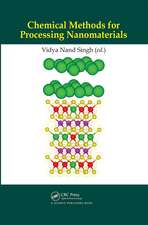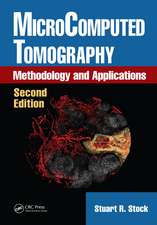Bonding through Code: Theoretical Models for Molecules and Materials
Autor Daniel C. Fredricksonen Limba Engleză Hardback – 17 sep 2020
Key Features
- Visualization of the Postulates of Quantum Mechanics to build conceptual understanding
- MATLAB functions for rendering molecular geometries and orbitals
- Do-it-yourself approach to building a molecular orbital and band theory program
- Introduction to Group Theory harnessing the 3D graphing capabilities of MATLAB
- Online access to a growing collection of applications of the core material and other appendices
About the Author
Daniel Fredrickson is a Professor in the Department of Chemistry at the University of Wisconsin–Madison, where his research group focuses on understanding and harnessing the structural chemistry of intermetallic phases using a combination of theory and experiment. His interests in crystals, structure, and bonding can be traced to his undergraduate research at the University of Washington (B.S. in Biochemistry, 2000) with Prof. Bart Kahr, his Ph.D. studies at Cornell University (2000–2005) with Profs. Stephen Lee and Roald Hoffmann, and his post-doctoral work with Prof. Sven Lidin at Stockholm University (2005–2008). As part of his teaching at UW–Madison since 2009, he has worked to enhance his department’s graduate course, Physical Inorganic Chemistry I: Symmetry and Bonding, through the incorporation of new material and the development of computer-based exercises.
| Toate formatele și edițiile | Preț | Express |
|---|---|---|
| Paperback (1) | 259.25 lei 6-8 săpt. | |
| CRC Press – aug 2022 | 259.25 lei 6-8 săpt. | |
| Hardback (1) | 683.54 lei 6-8 săpt. | |
| CRC Press – 17 sep 2020 | 683.54 lei 6-8 săpt. |
Preț: 683.54 lei
Preț vechi: 916.02 lei
-25% Nou
Puncte Express: 1025
Preț estimativ în valută:
130.80€ • 136.84$ • 108.65£
130.80€ • 136.84$ • 108.65£
Carte tipărită la comandă
Livrare economică 02-16 aprilie
Preluare comenzi: 021 569.72.76
Specificații
ISBN-13: 9781498762212
ISBN-10: 1498762212
Pagini: 244
Ilustrații: 32 Illustrations, color; 39 Illustrations, black and white
Dimensiuni: 156 x 234 x 20 mm
Greutate: 0.61 kg
Ediția:1
Editura: CRC Press
Colecția CRC Press
ISBN-10: 1498762212
Pagini: 244
Ilustrații: 32 Illustrations, color; 39 Illustrations, black and white
Dimensiuni: 156 x 234 x 20 mm
Greutate: 0.61 kg
Ediția:1
Editura: CRC Press
Colecția CRC Press
Public țintă
Academic and Professional Practice & DevelopmentCuprins
Contents
Acknowledgments, xi
About the Author, xiii
Chapter 1 ◾ The Postulates of Quantum Mechanics 1
Chapter 2 ◾ Atoms and Atomic Orbitals 23
INTRODUCTION 23
THE RADIAL WAVEFUNCTION 24
VISUALIZING ATOMIC ORBITALS WITH MATLAB: THE
ANGULAR WAVEFUNCTIONS 28
COMBINING THE RADIAL AND ANGULAR FUNCTIONS 35
FOCUSING ON THE VALENCE ELECTRONS: SLATER-TYPE
ORBITALS 38
Chapter 3 ◾ Overlap between Atomic Orbitals 41
INTRODUCTION 41
PARAMETERS FOR SLATER-TYPE ORBITALS 41
COMBINING THE RADIAL AND ANGULAR FUNCTIONS 42
VISUALIZING ISOSURFACES OF SLATER-TYPE ORBITALS 44
PROGRAMMING OVERLAP INTEGRALS IN MATLAB 47
EXERCISES FOR EXPLORING OVERLAP INTEGRALS 49
REFERENCES 53
Chapter 4 ◾ Introduction to Molecular Orbital Theory 55
INTRODUCTION 55
CONSTRUCTION OF THE HAMILTONIAN MATRIX 58
SOLVING FOR THE MOLECULAR ORBITALS 61
VISUALIZING ISOSURFACES OF MOS IN MATLAB 63
EXTENDED HÜCKEL VS. SIMPLE HÜCKEL 69
A SIMPLIFIED REPRESENTATION OF MOs IN MATLAB 72
REFERENCES 76
Chapter 5 ◾ The Molecular Orbitals of N2 77
INTRODUCTION 77
SOLVING THE GENERAL PROBLEM OF BUILDING THE
HAMILTONIAN 77
THE BRUTE FORCE SOLUTION OF THE MOs OF N2 84
SYMMETRIZED BASIS FUNCTIONS 85
Chapter 6 ◾ Heteronuclear Diatomic Molecules 93
INTRODUCTION 93
DRAWING MOLECULAR STRUCTURES 93
HeH: ELECTRONEGATIVITY PERTURBATION 97
HeH: INTERATOMIC INTERACTIONS AS A PERTURBATION 103
THE MOs OF CO AND CN− 106
Chapter 7 ◾ Symmetry Operations 109
INTRODUCTION 109
APPLYING SYMMETRY OPERATIONS IN MATLAB 109
THE IDENTITY OPERATION 112
INVERSION THROUGH A CENTRAL POINT 113
REFLECTIONS THROUGH A PLANE 114
ROTATIONS ABOUT AN AXIS 115
IMPROPER ROTATIONS 117
CREATING MORE COMPLICATED OPERATIONS 118
Chapter 8 ◾ Symmetry Groups 123
INTRODUCTION 123
PROPERTIES OF MATHEMATICAL GROUPS 123
DEMONSTRATION OF MATHEMATICAL GROUPS WITH
MATLAB 124
GENERATING OPERATIONS 128
APPLYING GROUP OPERATIONS 132
BUILDING THE MOLECULAR SYMMETRY GROUPS 135
Chapter 9 ◾ Group Theory and Basis Sets 139
INTRODUCTION 139
sp3 HYBRID ORBITALS OF H2O AS A BASIS FOR
REPRESENTING POINT GROUP SYMMETRY 139
BASIS SETS AS REPRESENTATIONS OF POINT GROUP
SYMMETRY 143
CHARACTERS OF A MATRIX REPRESENTATION 146
REDUCIBLE AND IRREDUCIBLE REPRESENTATIONS 147
REDUCTION OF REDUCIBLE REPRESENTATIONS 148
TRANSFORMATION OF BASIS SET TO IRREDUCIBLE
REPRESENTATIONS 151
Chapter 10 ◾ The MOs of H2O 153
INTRODUCTION 153
THE MOs OF H2O BY BRUTE FORCE 155
THE MOs OF H2O FROM SP3 HYBRID SYMMETRY
ADAPTED LINEAR COMBINATIONS (SALCs) 157
PERCEIVING LOCALIZED BONDING IN H2O 165
BONUS CODE: BETTER BALL-AND-STICK MODELS 166
Chapter 11 ◾ MOs of the Trigonal Planar Geometry 171
INTRODUCTION 171
CONSTRUCTION OF NH3 GEOMETRIES 171
MOs AT SPECIFIC GEOMETRIES 173
SALCs FOR THE TRIGONAL PLANAR GEOMETRY 175
BUILDING THE MO DIAGRAM FROM THE SALCs 182
Chapter 12 ◾ Walsh Diagrams and Molecular Shapes 185
INTRODUCTION 185
GEOMETRIES OF THE AL3 MOLECULE 185
CONSTRUCTING WALSH DIAGRAMS 186
Chapter 13 ◾ Getting Started with Transition Metals 191
INTRODUCTION 191
NORMALIZATION OF DOUBLE-ZETA FUNCTIONS 192
INCLUSION OF D ORBITALS INTO MATLAB FUNCTIONS 193
THE MOs OF AN OCTAHEDRAL COMPLEX WITH
σ-LIGANDS; THE 18-ELECTRON RULE 200
Chapter 14 ◾ Translational Symmetry and Band Structures 205
INTRODUCTION 205
TRANSLATIONAL SYMMETRY AND BLOCH’S THEOREM 205
CONSTRUCTING SALCs 208
HAMILTONIAN MATRICES 209
A SIMPLE EXAMPLE: THE CHAIN OF H ATOMS 210
UNIQUE VALUES OF K: THE 1ST BRILLOUIN ZONE 212
BUILDING THE HAMILTONIAN MATRICES FOR PERIODIC
STRUCTURES 213
EXAMPLE: THE BAND STRUCTURE OF GRAPHENE 220
DETERMINING THE FERMI ENERGY FOR GRAPHENE 223
INDEX, 227
Acknowledgments, xi
About the Author, xiii
Chapter 1 ◾ The Postulates of Quantum Mechanics 1
Chapter 2 ◾ Atoms and Atomic Orbitals 23
INTRODUCTION 23
THE RADIAL WAVEFUNCTION 24
VISUALIZING ATOMIC ORBITALS WITH MATLAB: THE
ANGULAR WAVEFUNCTIONS 28
COMBINING THE RADIAL AND ANGULAR FUNCTIONS 35
FOCUSING ON THE VALENCE ELECTRONS: SLATER-TYPE
ORBITALS 38
Chapter 3 ◾ Overlap between Atomic Orbitals 41
INTRODUCTION 41
PARAMETERS FOR SLATER-TYPE ORBITALS 41
COMBINING THE RADIAL AND ANGULAR FUNCTIONS 42
VISUALIZING ISOSURFACES OF SLATER-TYPE ORBITALS 44
PROGRAMMING OVERLAP INTEGRALS IN MATLAB 47
EXERCISES FOR EXPLORING OVERLAP INTEGRALS 49
REFERENCES 53
Chapter 4 ◾ Introduction to Molecular Orbital Theory 55
INTRODUCTION 55
CONSTRUCTION OF THE HAMILTONIAN MATRIX 58
SOLVING FOR THE MOLECULAR ORBITALS 61
VISUALIZING ISOSURFACES OF MOS IN MATLAB 63
EXTENDED HÜCKEL VS. SIMPLE HÜCKEL 69
A SIMPLIFIED REPRESENTATION OF MOs IN MATLAB 72
REFERENCES 76
Chapter 5 ◾ The Molecular Orbitals of N2 77
INTRODUCTION 77
SOLVING THE GENERAL PROBLEM OF BUILDING THE
HAMILTONIAN 77
THE BRUTE FORCE SOLUTION OF THE MOs OF N2 84
SYMMETRIZED BASIS FUNCTIONS 85
Chapter 6 ◾ Heteronuclear Diatomic Molecules 93
INTRODUCTION 93
DRAWING MOLECULAR STRUCTURES 93
HeH: ELECTRONEGATIVITY PERTURBATION 97
HeH: INTERATOMIC INTERACTIONS AS A PERTURBATION 103
THE MOs OF CO AND CN− 106
Chapter 7 ◾ Symmetry Operations 109
INTRODUCTION 109
APPLYING SYMMETRY OPERATIONS IN MATLAB 109
THE IDENTITY OPERATION 112
INVERSION THROUGH A CENTRAL POINT 113
REFLECTIONS THROUGH A PLANE 114
ROTATIONS ABOUT AN AXIS 115
IMPROPER ROTATIONS 117
CREATING MORE COMPLICATED OPERATIONS 118
Chapter 8 ◾ Symmetry Groups 123
INTRODUCTION 123
PROPERTIES OF MATHEMATICAL GROUPS 123
DEMONSTRATION OF MATHEMATICAL GROUPS WITH
MATLAB 124
GENERATING OPERATIONS 128
APPLYING GROUP OPERATIONS 132
BUILDING THE MOLECULAR SYMMETRY GROUPS 135
Chapter 9 ◾ Group Theory and Basis Sets 139
INTRODUCTION 139
sp3 HYBRID ORBITALS OF H2O AS A BASIS FOR
REPRESENTING POINT GROUP SYMMETRY 139
BASIS SETS AS REPRESENTATIONS OF POINT GROUP
SYMMETRY 143
CHARACTERS OF A MATRIX REPRESENTATION 146
REDUCIBLE AND IRREDUCIBLE REPRESENTATIONS 147
REDUCTION OF REDUCIBLE REPRESENTATIONS 148
TRANSFORMATION OF BASIS SET TO IRREDUCIBLE
REPRESENTATIONS 151
Chapter 10 ◾ The MOs of H2O 153
INTRODUCTION 153
THE MOs OF H2O BY BRUTE FORCE 155
THE MOs OF H2O FROM SP3 HYBRID SYMMETRY
ADAPTED LINEAR COMBINATIONS (SALCs) 157
PERCEIVING LOCALIZED BONDING IN H2O 165
BONUS CODE: BETTER BALL-AND-STICK MODELS 166
Chapter 11 ◾ MOs of the Trigonal Planar Geometry 171
INTRODUCTION 171
CONSTRUCTION OF NH3 GEOMETRIES 171
MOs AT SPECIFIC GEOMETRIES 173
SALCs FOR THE TRIGONAL PLANAR GEOMETRY 175
BUILDING THE MO DIAGRAM FROM THE SALCs 182
Chapter 12 ◾ Walsh Diagrams and Molecular Shapes 185
INTRODUCTION 185
GEOMETRIES OF THE AL3 MOLECULE 185
CONSTRUCTING WALSH DIAGRAMS 186
Chapter 13 ◾ Getting Started with Transition Metals 191
INTRODUCTION 191
NORMALIZATION OF DOUBLE-ZETA FUNCTIONS 192
INCLUSION OF D ORBITALS INTO MATLAB FUNCTIONS 193
THE MOs OF AN OCTAHEDRAL COMPLEX WITH
σ-LIGANDS; THE 18-ELECTRON RULE 200
Chapter 14 ◾ Translational Symmetry and Band Structures 205
INTRODUCTION 205
TRANSLATIONAL SYMMETRY AND BLOCH’S THEOREM 205
CONSTRUCTING SALCs 208
HAMILTONIAN MATRICES 209
A SIMPLE EXAMPLE: THE CHAIN OF H ATOMS 210
UNIQUE VALUES OF K: THE 1ST BRILLOUIN ZONE 212
BUILDING THE HAMILTONIAN MATRICES FOR PERIODIC
STRUCTURES 213
EXAMPLE: THE BAND STRUCTURE OF GRAPHENE 220
DETERMINING THE FERMI ENERGY FOR GRAPHENE 223
INDEX, 227
Notă biografică
Daniel Fredrickson is a Professor in the Department of Chemistry at
the University of Wisconsin–Madison, where his research group focuses
on understanding and harnessing the structural chemistry of intermetallic
phases using a combination of theory and experiment. His
interests in crystals, structure and bonding can be traced to his undergraduate
research at the University of Washington (B.S. in Biochemistry,
2000) with Prof. Bart Kahr, his Ph.D. studies at Cornell University
(2000–2005) with Profs. Stephen Lee and Roald Hoffmann, and his
post-doctoral work with Prof. Sven Lidin at Stockholm University
(2005–2008). As part of his teaching at UW–Madison since 2009, he has
worked to enhance his department’s graduate course Physical Inorganic
Chemistry I: Symmetry and Bonding, through the incorporation of new
material and the development of computer-based exercises.
the University of Wisconsin–Madison, where his research group focuses
on understanding and harnessing the structural chemistry of intermetallic
phases using a combination of theory and experiment. His
interests in crystals, structure and bonding can be traced to his undergraduate
research at the University of Washington (B.S. in Biochemistry,
2000) with Prof. Bart Kahr, his Ph.D. studies at Cornell University
(2000–2005) with Profs. Stephen Lee and Roald Hoffmann, and his
post-doctoral work with Prof. Sven Lidin at Stockholm University
(2005–2008). As part of his teaching at UW–Madison since 2009, he has
worked to enhance his department’s graduate course Physical Inorganic
Chemistry I: Symmetry and Bonding, through the incorporation of new
material and the development of computer-based exercises.
Descriere
This timely and unique publication is designed for graduates and researchers in physical inorganic chemistry covering bonding models and applications of symmetry concepts to chemical systems. The book discusses the quantum mechanical basis for molecular orbital concepts, the connections between molecular orbitals and localized views of bonding, group theory, and bonding models for a variety of compounds. Unlike other books, the concepts are made tangible to the readers by guiding them through the implementation in Matlab functions. No background in Matlab or computer programming is needed and the book will provide the necessary skills.













